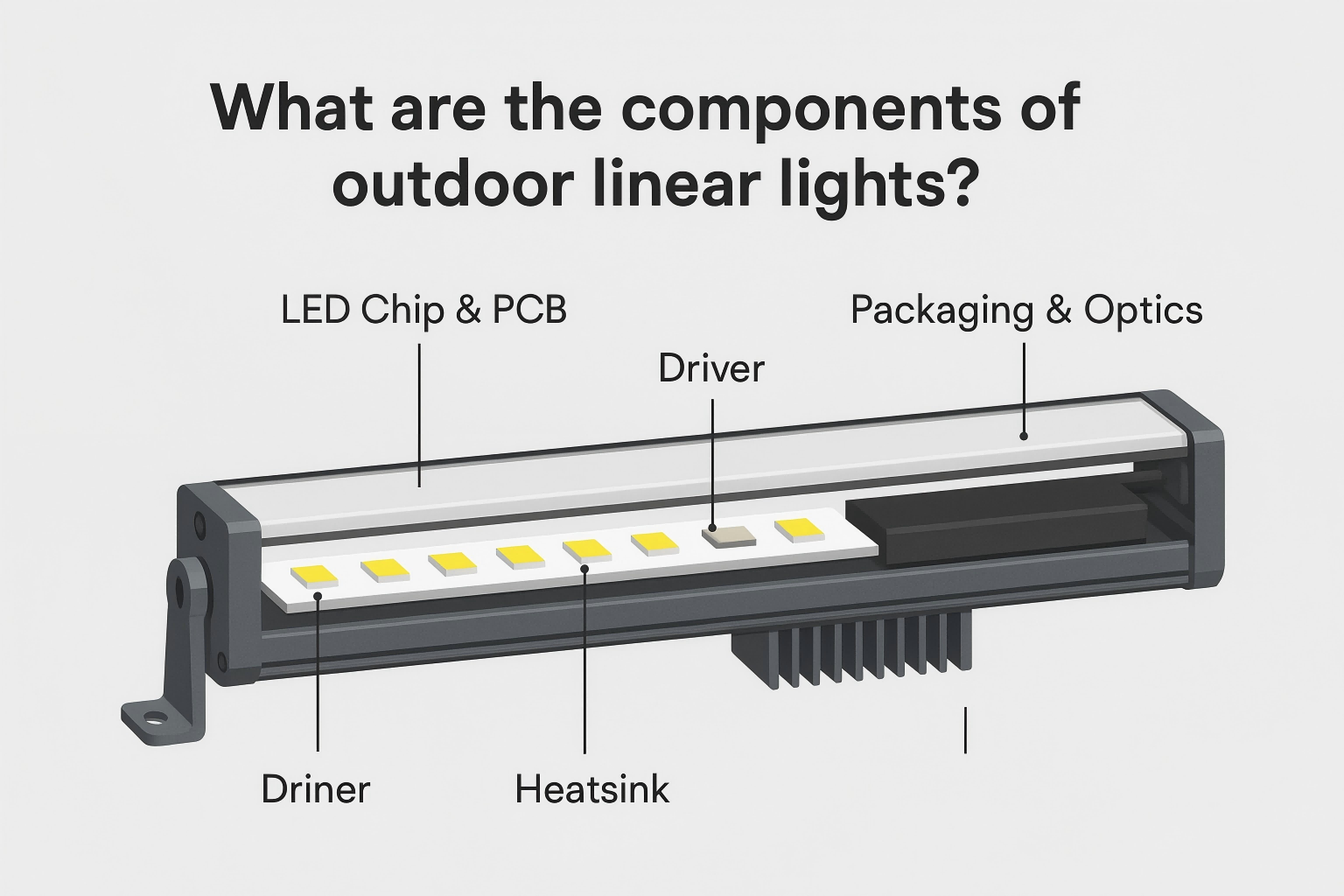Choosing Between High Voltage and Low Voltage for Outdoor Lighting: The Complete Guide
From lighting up a cozy garden pathway, to powering security floodlights, each use case defines whether to choose a high-voltage outdoor lighting (120V/230V) or low-voltage outdoor lighting (12V/24V) outdoor lighting system. Read on to understand how high and low voltage differ in safety, cost, and installation. Whether you require a sustained illumination for a wide driveway or a simple home improvement project that requires minimal effort, your choice of outdoor lighting system should go beyond just the level of illumination. Today we're going to talk about the choice that has troubled countless homeowners: high voltage or low voltage?
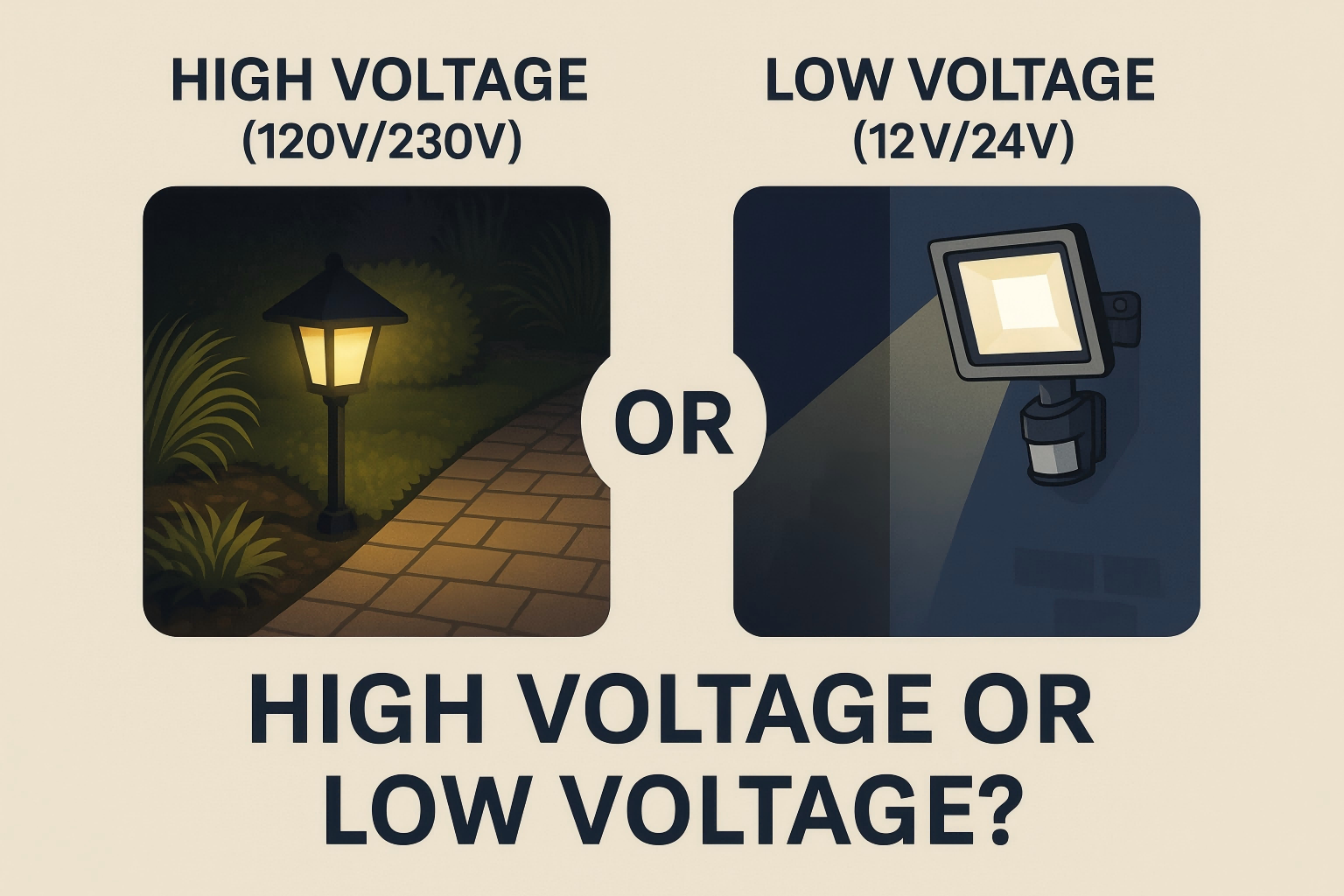
1. The underlying logic of voltage differences
1.1) Definition and voltage range:
High-voltage outdoor lighting is like a muscular athlete. It can output a strong beam of light directly connected to the household circuit. I have worked on a community square project. The 30-meter-high palm tree relies on high-voltage LEDs for lighting. The 200-watt power of a single lamp makes the entire tree canopy look like a luminous sculpture at night. However, this type of system has an invisible threshold: when I disassembled a faulty lamp, I found ants building nests at the wiring point - the heat generated by the high-voltage system has become a hotbed for insects.
Low-voltage outdoor lighting is like flexible gymnasts. I remember a customer installed a low-voltage light strip by the swimming pool. As a result, the naughty child dragged the light strip into the water. Fortunately, the 12V voltage did not cause a disaster. This type of system requires the transformer to "slim down" and reduce the mains power to a safe range. Although there is an additional device, the safety factor rises sharply. However, in the sea view villa project last year, the salt mist in the sea breeze corroded the transformer contacts in three months, which taught me a vivid lesson: low voltage does not mean maintenance-free.
1.2) Brief description of working principle:
High-voltage outdoor lighting principle: The lamp is directly connected to the mains line without the need for an additional transformer. The current passes through the internal resistance of the bulb to generate heat or excite the semiconductor light-emitting element, thereby outputting high-intensity lighting.
Low-voltage outdoor lighting principle: The mains power is first stepped down to the target voltage by a transformer, and then the low-voltage current is transmitted to the lamp through the wire. The LED or halogen element in the lamp emits light at a low voltage, which can not only ensure stable brightness, but also reduce line power loss.
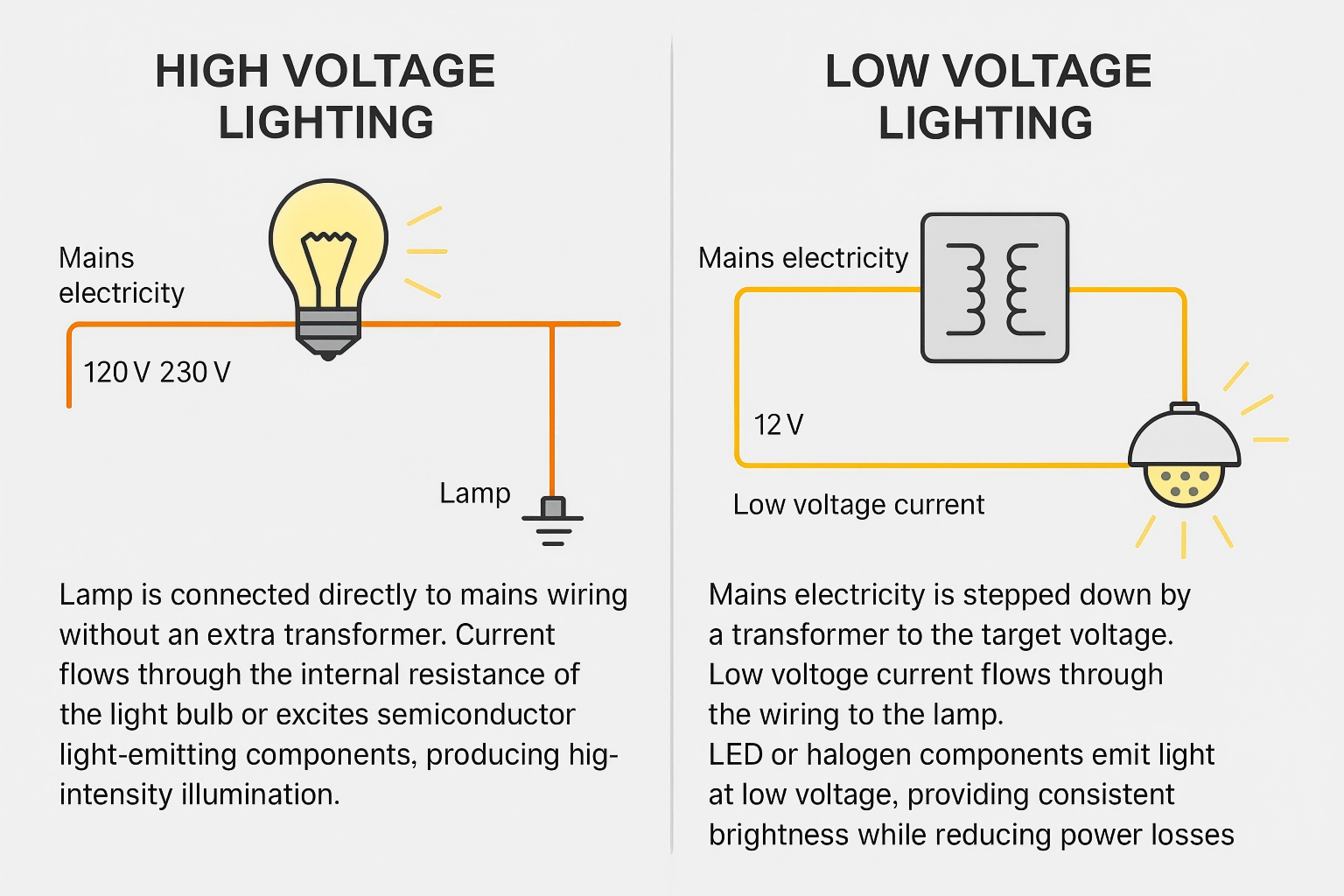
2. The real dilemma in selection
2.1) Characteristics of high-voltage lighting:
High-voltage outdoor lighting system: strong light, wide coverage area, lamps can output strong and uniform lighting, no transformer required: the system structure is simpler, reducing additional equipment investment and failure links, greatly improving the reliability of installation and operation, suitable for large-scale lighting needs such as parking lots, roads, squares, etc., and can maintain good lighting effects at tens or even hundreds of meters.
High-voltage outdoor lighting also has some shortcomings: high energy consumption and high power, long-term high-load work will lead to higher electricity bills and greater carbon emissions. High maintenance cost: all wiring and buried pipes must comply with electrical safety regulations and must be constructed by certified electricians to avoid the risk of electric shock and fire.
2.2) Characteristics of low-voltage lighting:
Low-voltage outdoor lighting system: low energy consumption, higher energy efficiency of LED light sources; flexible installation, support DIY quick installation and later lamp position adjustment, high safety, greatly reducing the risk of electric shock accidents, suitable for use in family courtyards and public gardens with children and pets.
The drawbacks of low-voltage outdoor lighting include light decay and drop in voltage: with the increase in length of the line, the voltage decays greatly, and the terminal lamps may not be sufficiently bright or may flicker. It is essential to rationally design the location and wire radius of the transformer, and the output luminous flux of the low-voltage lamps is low, which does not suit requirements of the scenes for large area and high brightness coverage.
2.3) Application scenarios of high voltage outdoor lighting and low voltage outdoor lighting
When designing the lighting for a certain homestay, the boss insisted on a low-voltage system to save money. As a result, after the trial installation, it was found that the lights at the end of the 30-meter-long bamboo forest trail were obviously dim, and finally a transformer had to be installed halfway. This lesson tells us that although low voltage is good, the line planning must be exquisite. My current rule of thumb is that for every 15 meters of line added, the voltage drop will eat up about 1.2V of brightness, which is equivalent to putting a layer of gauze on the light.
The high-voltage system also has embarrassing moments. During an acceptance inspection, it was found that the workers buried the junction box in the automatic sprinkler area of the flower bed, resulting in frequent tripping in the rainy season. What's worse, the newly laid granite floor tiles need to be dug up for maintenance, which causes more time and cost. This made me understand that the requirements for construction accuracy of high-voltage lighting are really ten times more stringent than imagined.
3. The game between safety and cost
The risk of electric shock is not a numbers game. I have measured that the leakage current of a 12V system in a humid environment is less than 0.5mA, while the leakage current of a 120V system may reach 5mA even if it meets the safety standards. Although both are within the safe range, the numbness brought by the latter is enough to make people panic. One customer described it as "like being pinched by a crab", and I still remember this metaphor.
Energy consumption accounts should be calculated in the long term. A comparison of a villa project found that the annual electricity bill of 20 5W low-voltage LEDs is about 240 yuan, while the high-voltage halogen lamps of the same brightness cost 1,800 yuan. However, the owner reported that the low-voltage system replaced the transformer twice in three years, and the maintenance cost recovered. Now I will recommend customers to make a five-year cost curve: make a line chart of electricity bills, maintenance costs, and lamp replacement rates, and often see dramatic intersections.
Installation convenience is also important for cost. Low-voltage lighting lines do not require conduits and are often equipped with quick-plug connectors, which support DIY rapid wiring and later position adjustment. In contrast, high-voltage lighting requires certified electricians to bury pipes and wire according to specifications, and grounding and waterproofing measures must be considered. The installation complexity and maintenance costs are relatively high.
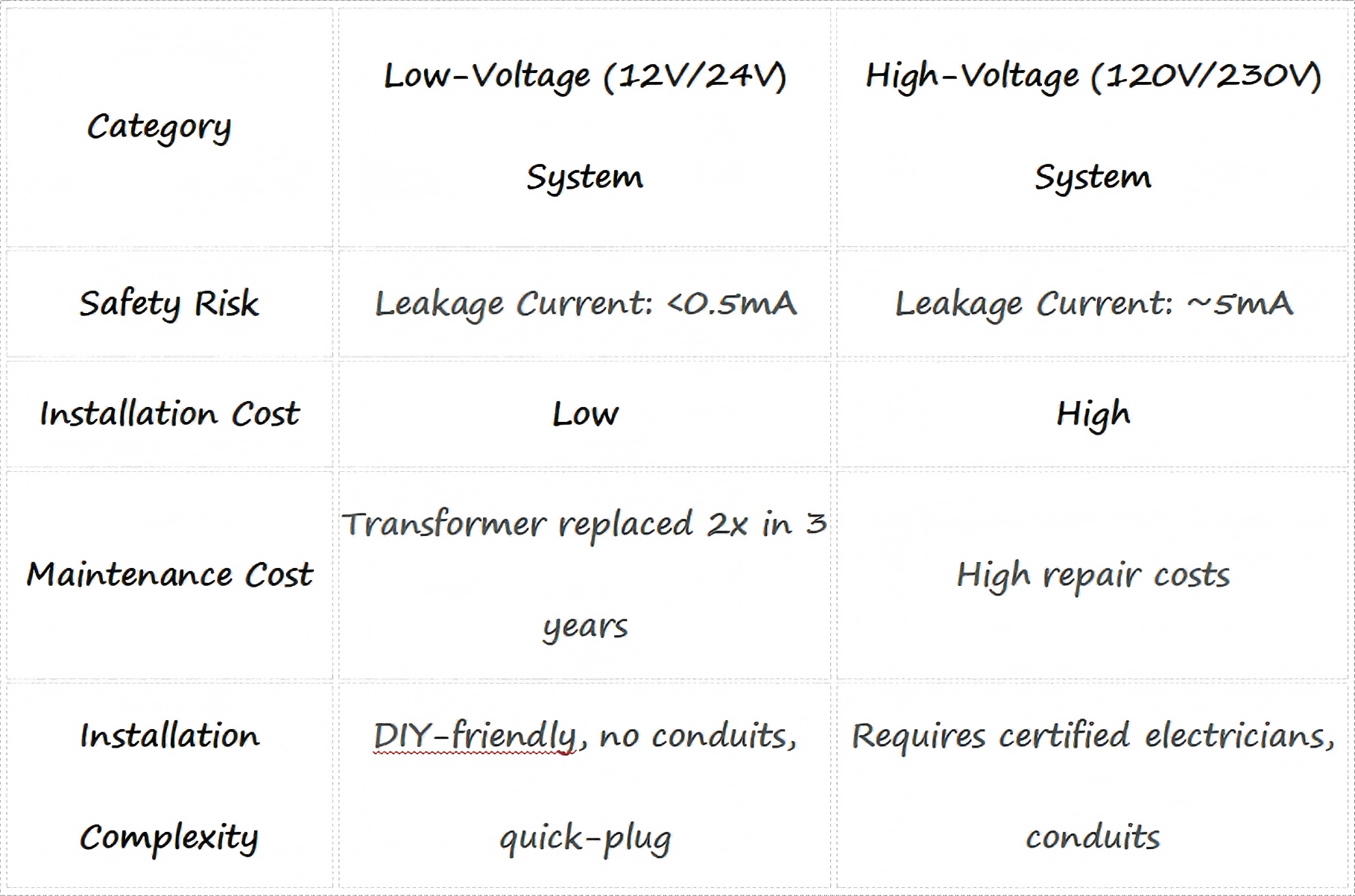
4. Practical skills in installation
4.1) There are tricks to low-voltage wiring:
Transformer capacity selection: 20–30% margin should be reserved according to the total power of the lamp. For example, if the total power of the system is 120 W, it is advisable to use a 150 W or higher multi-speed transformer to take into account the line voltage fluctuation and the need for later expansion.
I often use the "37 rule": the distance from the transformer to the first lamp does not exceed 30% of the total line, so that the terminal voltage drop can be controlled within 8%.
Wiring specifications: Low-voltage lines can be buried directly or laid in open wire pipes. If pipes need to be passed, it is recommended to use PVC irrigation pipes and leave enough margin at the pipe mouth for maintenance; line joints must be encapsulated with waterproof joints or heat shrink tubes to prevent water vapor intrusion.
4.2) The life and death line of high-voltage construction is waterproofing:
Waterproof junction box selection: IP65 or higher junction boxes must be used for outdoor burial or humid areas; if buried, IP68 should be selected, or waterproof glue or epoxy sealant should be filled in the IP65 box to improve waterproof performance.
Junction box layout and laying: The junction box should be installed in a convenient location for maintenance, with drainage holes at the bottom or tilted installation to ensure that the accumulated water can be discharged in time; all cable entrances must be equipped with waterproof sealing sleeves or cable clamps to prevent external water vapor from infiltrating.
Due to the inadequate sealing of the junction box in a certain project, the entire line short-circuited after a heavy rain. Now our standard process is: junction box glue filling + bellows protection + insulation detection three-piece set.
4.3) Maintenance suggestions: Regularly check the insulation and clean the lamps.
Insulation and line inspection: Check the sealing condition of all lines and junction boxes every six months to confirm that there are no cracks, aging or water vapor intrusion; visually inspect the transformer and the inside of the junction box, and use a megohmmeter to test the insulation resistance to ensure ≥1 MΩ.
Lamp cleaning and maintenance: Regularly remove dust, leaves and other debris from the surface of the lamp, keep the heat sink and lens clean to avoid overheating or light decay; it is recommended to wipe it once a year with a neutral detergent, and check whether the sealing ring and fasteners are aging and loose.
Functional testing: Test the timer, light sensor switch and GFCI protection device every quarter to confirm their sensitivity and operational reliability; if any abnormality is found, replace or adjust them in time to ensure system safety and energy-saving effects.
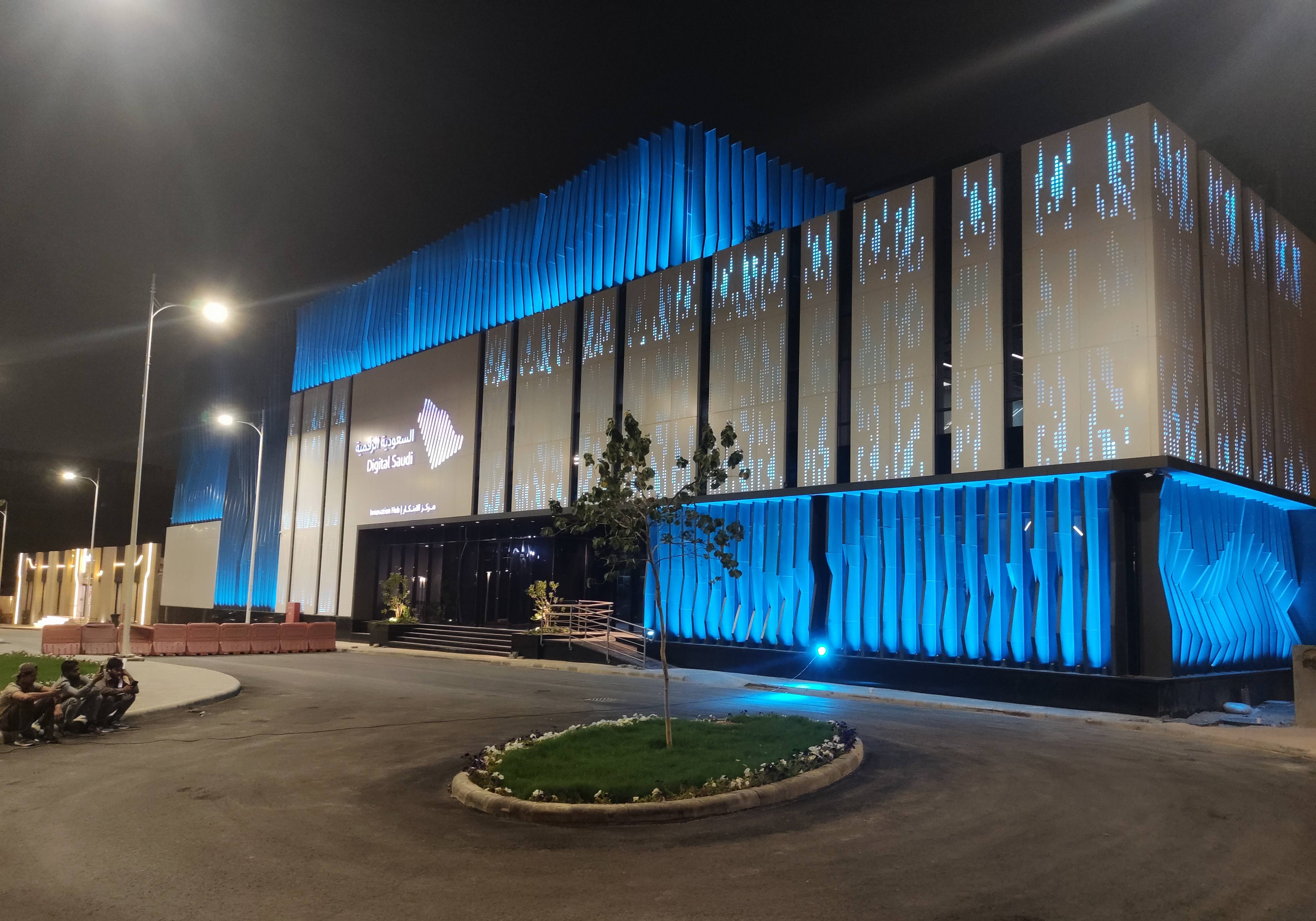
5. Scenario-based selection guide
Let me talk about my selection "three tricks":
5.1) Three-step test method:
First, measure the distance (be careful to choose low voltage if it exceeds 15 meters), then look at the environment (low voltage must be chosen if there are many water features), and finally ask about the purpose (low voltage is preferred for decoration, and high voltage is considered for security)
5.2) Garden lighting brand recommendation: LNJAMI's intelligent lighting philosophy
If you are troubled by the choice of high voltage/low voltage, LNJAMI's "Scene Adaptive Lighting System" may be able to put an end to the entanglement. We use intelligent voltage-stabilizing chips to control the voltage attenuation of a 30-meter line to less than 3% (the traditional solution attenuates by 12%), perfectly solving the problem of light attenuation at the end of the bamboo forest trail of the homestay mentioned in the article; the high-voltage series adopts a honeycomb heat dissipation structure and a pre-sealed junction box above IP65, which not only eliminates the heat hazards caused by ants building nests, but also avoids the risk of short circuits caused by rainstorm seepage. LNJAMI provides low-voltage transformers with anti-corrosion coatings and high-voltage floodlights with color temperature calibration, and also launches a high- and low-voltage mix-and-match design service to help you solve outdoor lighting problems with one click, and let professional solutions help you balance safety and cost.
5.3) Upgrade space reservation:
It is recommended to reserve 30% transformer margin for low-voltage systems (for example, 100W lamps are equipped with 130W transformers).
It is best to pre-bury spare pipes for high-voltage lines (no need to ask for help in the future to install monitoring power supply).
I encountered a typical case: a 200-square-meter lakeside courtyard, and finally adopted a high-low voltage mixed solution - the trail is outlined with low-voltage LEDs, and the hydrophilic platform uses high-voltage floodlights to create a dramatic effect. The best thing is that at the corner of the plank road, we embedded a low-voltage underground lamp that changes color, and the water level rises and automatically switches to a red warning. This combination not only ensures the safety of the safe area, but also does not compromise where strong light is needed, which may give the entangled owners new ideas.
6. Cold knowledge in the industry
The secret relationship between voltage and color temperature: The color temperature of high-voltage LEDs is generally 500K higher than the nominal value. This is the "blue shift" phenomenon caused by the heating of the driver chip.
The psychology of anti-theft lighting: A high-voltage floodlight that suddenly turns on can cause the intruder's heart rate to soar by 17%, while a gradually brightening low-voltage lamp has only a 5% effect.
The voltage metaphysics of plant lighting: A 12V system is more suitable for 3000K warm light, and excessive voltage will inhibit the night breathing of some flowers
Conclusion
Lighting design is ultimately the art of light and shadow. An old master once said: "Good lighting should be like air, invisible but indispensable." The key to choosing the right voltage level is to accurately match the scene requirements with the safety cost budget. Next time you pick up a lighting catalog, you might as well ask yourself: What kind of light does this corner need to tell? Is it the sonorous declaration of the high-voltage system, or the gentle whisper of the low-voltage light? Perhaps the answer is hidden in those illuminated shadows.
FAQ (for Schema integration later)
Q1: Which is safer, high or low voltage outdoor lighting?
A: Low-voltage systems (12V/24V) are safer, especially in wet environments or family spaces.
Q2: Can I mix both high and low voltage in one project?
A: Yes. Hybrid setups can combine safety and performance when designed correctly.
Q3: How do I calculate voltage drop in low-voltage lines?
A: On average, voltage drops about 1.2V per 15 meters of cable; use thicker wire or shorter segments to reduce loss.






